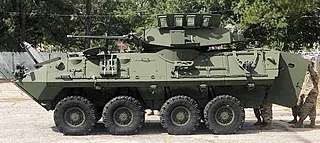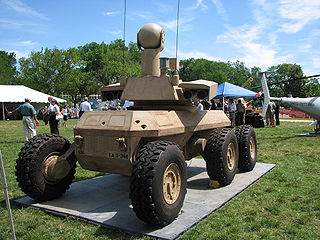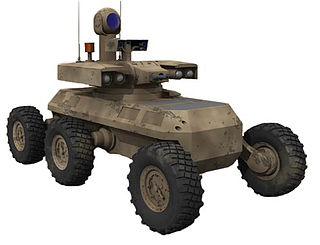
An armoured fighting vehicle (AFV) is an armed combat vehicle protected by armour, generally combining operational mobility with offensive and defensive capabilities. AFVs can be wheeled or tracked. Examples of AFVs are tanks, armoured cars, assault guns, self-propelled guns, infantry fighting vehicles, and armoured personnel carriers.

A military engineering vehicle is a vehicle built for construction work or for the transportation of combat engineers on the battlefield. These vehicles may be modified civilian equipment or purpose-built military vehicles. The first appearance of such vehicles coincided with the appearance of the first tanks, these vehicles were modified Mark V tanks for bridging and mine clearance. Modern military engineering vehicles are expected to fulfill numerous roles, as such they undertake numerous forms, examples of roles include; bulldozers, cranes, graders, excavators, dump trucks, breaching vehicles, bridging vehicles, military ferries, amphibious crossing vehicles, and combat engineer section carriers.

An infantry fighting vehicle (IFV), also known as a mechanized infantry combat vehicle (MICV), is a type of armoured fighting vehicle used to carry infantry into battle and provide direct-fire support. The 1990 Treaty on Conventional Armed Forces in Europe defines an infantry fighting vehicle as "an armoured combat vehicle which is designed and equipped primarily to transport a combat infantry squad, and which is armed with an integral or organic cannon of at least 20 millimeters calibre and sometimes an antitank missile launcher". IFVs often serve both as the principal weapons system and as the mode of transport for a mechanized infantry unit.

The Bradley Fighting Vehicle (BFV) is a tracked armoured fighting vehicle platform of the United States developed by FMC Corporation and manufactured by BAE Systems Land & Armaments, formerly United Defense. It is named after U.S. General Omar Bradley.

The Stryker is a family of eight-wheeled armored fighting vehicles derived from the Canadian LAV III. Stryker vehicles are produced by General Dynamics Land Systems-Canada (GDLS-C) for the United States Army in a plant in London, Ontario. It has four-wheel drive (8×4) and can be switched to all-wheel drive (8×8).

The Leopard 2 is a 3rd generation main battle tank originally developed by Krauss-Maffei in the 1970s for the West German army. The tank first entered service in 1979 and succeeded the earlier Leopard 1 as the main battle tank of the West German Army. It is armed with a 120 mm smoothbore cannon, and is powered by a V-12 twin-turbo diesel engine. Various versions have served in the armed forces of Germany and 13 other European countries, as well as several non-European nations, including Canada, Chile, Indonesia, and Singapore. The Leopard 2 was used in Kosovo with the German Army, in Afghanistan with the Dutch, Danish and Canadian contributions to the International Security Assistance Force, and saw action in Syria with the Turkish Armed Forces.

Oshkosh Corporation, formerly Oshkosh Truck, is an American industrial company that designs and builds specialty trucks, military vehicles, truck bodies, airport fire apparatus, and access equipment. The corporation also owns Pierce Manufacturing, a fire apparatus manufacturer in Appleton, Wisconsin, and JLG Industries, a leading manufacturer of lift equipment, including aerial lifts, boom lifts, scissor lifts, telehandlers and low-level access lifts. Based in Oshkosh, Wisconsin, the company employs approximately 16,000 people around the world. It is organized in four primary business groups: access equipment, defense, fire and emergency, and commercial.

Future Combat Systems (FCS) was the United States Army's principal modernization program from 2003 to early 2009. Formally launched in 2003, FCS was envisioned to create new brigades equipped with new manned and unmanned vehicles linked by an unprecedented fast and flexible battlefield network. The U.S. Army claimed it was their "most ambitious and far-reaching modernization" program since World War II. Between 1995 and 2009, $32 billion was expended on programs such as this, with little to show for it.

An unmanned ground vehicle (UGV) is a vehicle that operates while in contact with the ground and without an onboard human presence. UGVs can be used for many applications where it may be inconvenient, dangerous, or impossible to have a human operator present. Generally, the vehicle will have a set of sensors to observe the environment, and will either autonomously make decisions about its behavior or pass the information to a human operator at a different location who will control the vehicle through teleoperation.

The LAV-25 is a member of the LAV II family. It is an eight-wheeled amphibious armored reconnaissance vehicle built by General Dynamics Land Systems and used by the United States Marine Corps and the United States Army.

The XM1219 Armed Robotic Vehicle was an unmanned ground combat vehicle based on the MULE Platform. The ARV-A-L MULE Vehicle (XM1219) would feature integrated anti-tank and anti-personnel and reconnaissance, surveillance, and target acquisition (RSTA) systems remotely operated by network linked soldiers. The Armed robotic vehicle was canceled in July 2011 over mobility concerns.

The Manned Ground Vehicles (MGV) was a family of lighter and more transportable ground vehicles developed by BAE Systems and General Dynamics as part of the U.S. Army's Future Combat Systems (FCS) program. The MGV program was intended as a successor to the Stryker of the Interim Armored Vehicle program.

The Ground Combat Vehicle (GCV) was the United States Army's replacement program for armored fighting vehicles in Armored and Stryker brigade combat teams. The GCV was organized under the Follow On Incremental Capabilities Package of the BCT Modernization program. The first variant of the vehicle was to be prototyped in 2015 and fielded by 2017. It replaced the canceled Future Combat Systems, manned ground vehicles program. The GCV program was cancelled in February 2014. Its replacement was the Optionally Manned Fighting Vehicle.

The BCT Common controller (CC) serves as a controller for many different BCT unmanned systems.
FCS/BCT unmanned aerial vehicles was a collection of unmanned aerial vehicles developed under the jurisdiction of the Future Combat Systems (FCS) program until it was dissolved and succeeded by the BCT Modernization program.

The M2 Bradley, or Bradley IFV, is an American infantry fighting vehicle that is a member of the Bradley Fighting Vehicle family. It is manufactured by BAE Systems Land & Armaments, which was formerly United Defense.

The Autonomous Navigation System (ANS) was a 2007-2011 combat vehicle upgrade used to convert manned vehicles to autonomous unmanned capability or to upgrade already unmanned vehicles to be autonomous.
The Armored Systems Modernization (ASM) was a U.S. Army combat vehicle procurement program canceled in 1992. The Army sought to develop a family of six armored vehicles based on two common chassis, one heavy and one medium, which would both share commonalities. Systems that the ASM sought to replace included the M1 Abrams main battle tank, M109 howitzer and M2 Bradley infantry fighting vehicle. The Army spun out several of the systems—Advanced Field Artillery System, Line-of-Sight Anti-Tank and the Armored Gun System—after canceling the program, but all of these programs were eventually canceled.

The Mobile Protected Firepower (MPF) system is a U.S. Army program to procure a light tank that is capable of providing mobile, protected, direct, offensive fire capability. The program is part of the Next Generation Combat Vehicle program. A previous light tank development for the Army, the M8 Armored Gun System, was canceled in 1996.
















